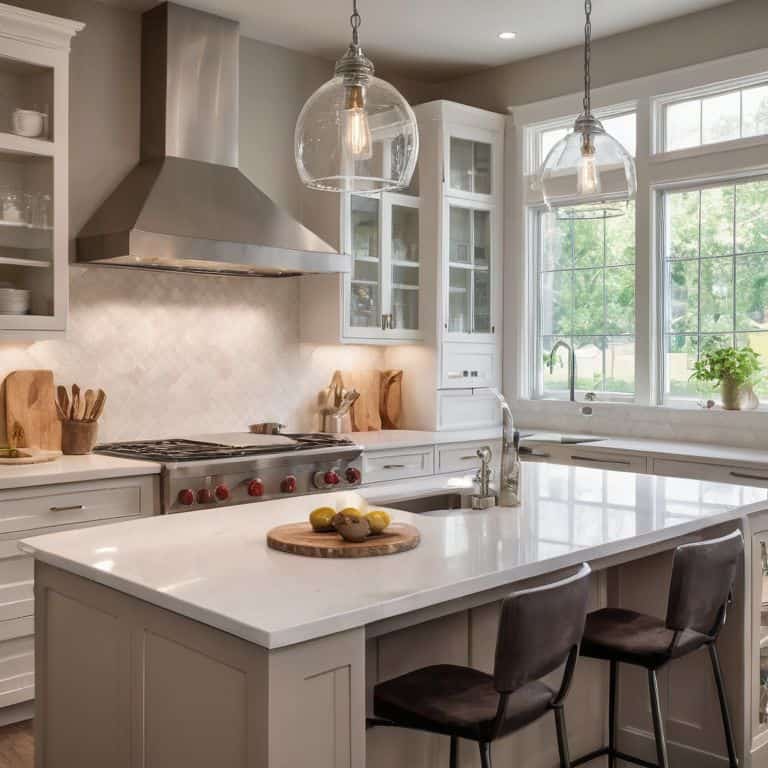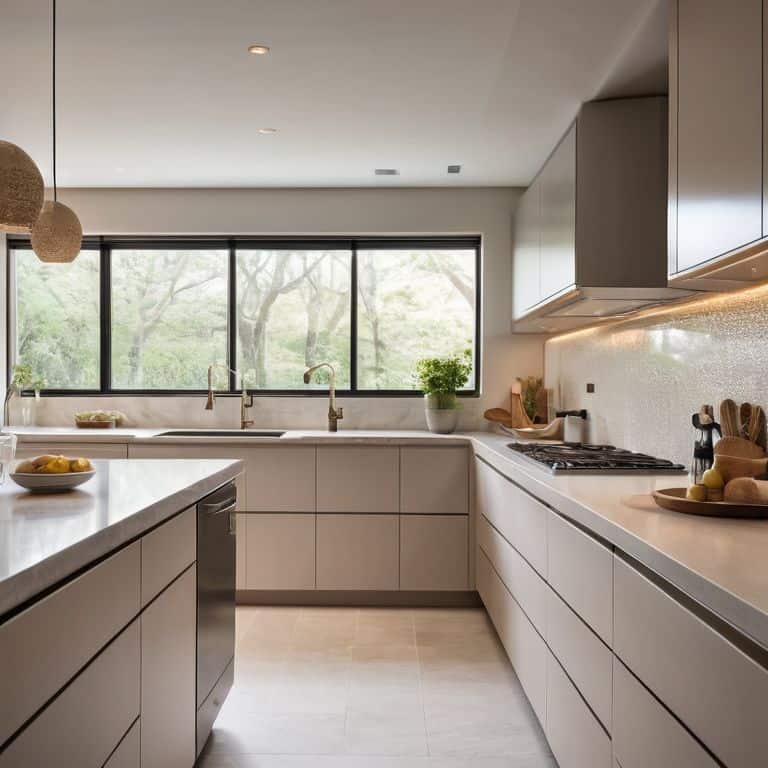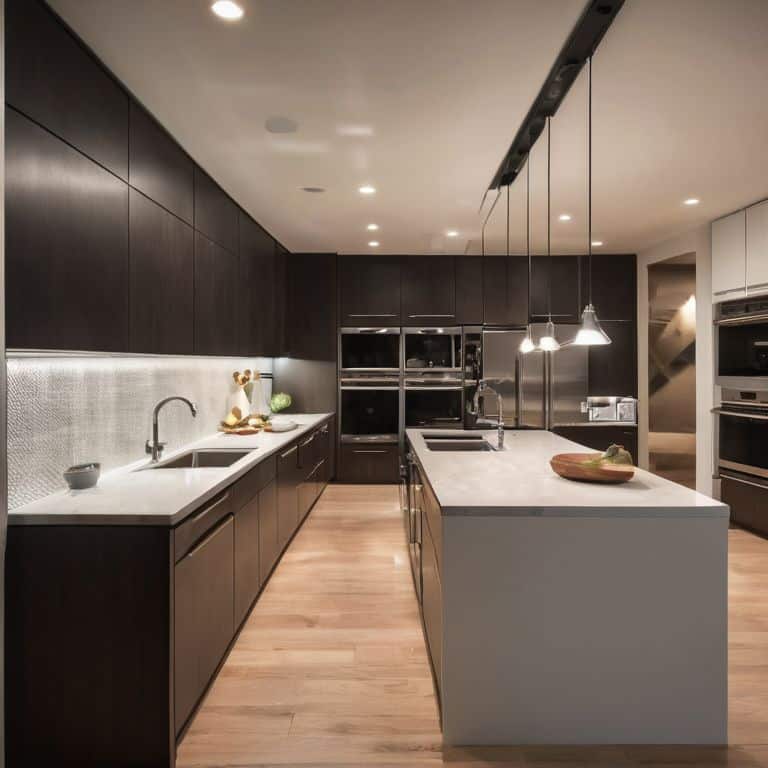I still remember the day I realized that a guide to kitchen lighting was not just about installing a few fancy fixtures, but about creating an ambiance that inspires culinary creativity. As I was hosting a dinner party in my own kitchen, I noticed how the warm glow of my pendant lights above the island made everyone feel cozy and eager to cook. It was then that I understood the power of lighting in transforming a kitchen from a mere cooking space to a warm and inviting hub of the home.
In this article, I promise to share my expertise as an interior designer to provide you with practical and achievable advice on how to create a kitchen lighting plan that works for you. You’ll learn how to balance function and ambiance, and discover the best lighting solutions for your specific kitchen layout and style. Whether you’re a busy home cook or an avid entertainer, I’ll guide you through the process of designing a lighting scheme that enhances your cooking experience and makes your kitchen a true culinary sanctuary.
Table of Contents
Guide Overview: What You'll Need

Total Time: 2 hours 30 minutes
Estimated Cost: $50 – $100
Difficulty Level: Intermediate
Tools Required
- Drill (with screwdriver and drill bits)
- Level (to ensure proper installation)
- Pliers (for gripping and bending)
- Wire Strippers (for stripping electrical wires)
- Voltage Tester (for safety precautions)
Supplies & Materials
- LED Light Fixtures (various sizes and styles)
- Light Switches (compatible with LED fixtures)
- Electrical Wire (14-gauge or 12-gauge, depending on the setup)
- Wire Nuts (for secure connections)
- Mounting Hardware (screws, anchors, etc.)
Step-by-Step Instructions
- 1. First, let’s start by assessing your current kitchen lighting situation – take a step back and observe how light falls in your kitchen throughout the day. Notice any areas that seem dimly lit or harshly lit, as this will help you identify where to focus your lighting design efforts. Consider the natural light sources in your kitchen and how you can work with them to create a cohesive lighting plan.
- 2. Next, think about the different layers of lighting you want to achieve in your kitchen – this includes ambient lighting, task lighting, and accent lighting. Ambient lighting provides overall illumination, while task lighting focuses on specific areas like countertops and sinks. Accent lighting, on the other hand, is used to highlight particular features or decorative elements, creating a sense of visual interest.
- 3. Now, let’s talk about the different types of lighting fixtures you can use to achieve your desired lighting layers – consider a combination of overhead lighting, such as recessed lights or pendant lights, to provide ambient lighting. For task lighting, look into installing under-cabinet lighting to illuminate your countertops and make food preparation easier. Don’t forget about dimmer switches, which can help you adjust the lighting levels to suit different tasks and moods.
- 4. When it comes to selecting the right light bulbs, think about the color temperature and lumen output that will work best for your kitchen. Warm white light bulbs (2700K-3000K) can create a cozy atmosphere, while cool white light bulbs (3500K-5000K) can provide a brighter, more energizing light. Be sure to choose bulbs with the right lumen output for each fixture to ensure you’re getting the desired level of brightness.
- 5. To add some extra flair to your kitchen lighting, consider incorporating unique lighting fixtures that reflect your personal style – this could be a show-stopping chandelier above your island or a vintage pendant light above your sink. Don’t be afraid to mix and match different lighting styles to create a look that’s all your own. Just remember to balance your statement pieces with more understated lighting elements to avoid overwhelming the space.
- 6. As you’re planning your kitchen lighting, keep the kitchen work triangle in mind – this refers to the area between your sink, stove, and refrigerator. Make sure this high-traffic zone is well-lit to improve safety and efficiency. Consider installing task lighting specifically in this area, such as under-cabinet lighting or a pendant light above the island, to create a well-lit workflow.
- 7. Finally, don’t forget to test and adjust your lighting plan once it’s in place – you may find that you need to make some tweaks to get the perfect balance of light and ambiance. Take note of how the lighting looks at different times of day and adjust your dimmer switches accordingly. With a little patience and experimentation, you’ll be enjoying a beautifully lit kitchen that’s both functional and inspiring.
A Guide to Kitchen Lighting

As I always say, good lighting is key to a functional and beautiful kitchen. When it comes to achieving this, I swear by layered lighting design. It’s all about combining different light sources to create a space that’s both inviting and efficient. For instance, you can pair overhead lighting with under-cabinet LED lights to create a warm and welcoming ambiance.
To take your kitchen to the next level, consider exploring kitchen island lighting ideas. This can include pendant lights, chandeliers, or even recessed lighting. The key is to find a balance between form and function, ensuring that your lighting choices not only look great but also provide ample illumination for food preparation. I’ve seen many homeowners opt for recessed lighting layout to create a sleek and modern look, and it’s definitely a trend worth considering.
When it comes to customizing your lighting, dimming options for kitchens are a must. Not only do they allow you to adjust the ambiance to suit your mood, but they also help reduce energy consumption. As someone who’s passionate about energy efficient lighting solutions, I always recommend exploring options that are both eco-friendly and stylish. By making a few simple changes to your lighting, you can create a kitchen that’s not only beautiful but also functional and sustainable.
Efficient Led Solutions
When it comes to efficient lighting, LED solutions are a game-changer. Not only do they use significantly less energy than traditional lighting options, but they also last much longer. I’ve seen firsthand how LED strips can be used to create a beautiful ambient glow under cabinets or inside glass-fronted cabinets. Plus, they’re incredibly versatile – you can find LED bulbs in a range of color temperatures to suit your kitchen’s unique style.
For a sleek, modern look, consider installing LED tape lights under your kitchen island or peninsula. This will not only provide additional task lighting but also create a warm, inviting ambiance in the evening. And with many LED options being dimmable, you can easily adjust the lighting to suit your mood and the time of day.
Layered Lighting for Joy
To create a truly inviting atmosphere, I always recommend incorporating layered lighting into your kitchen design. This means combining overhead lighting, task lighting, and ambient lighting to craft a warm and welcoming space. By layering different light sources, you can adjust the mood and functionality of your kitchen to suit any occasion – from a bright and airy morning breakfast to a cozy dinner party.
I love using a combination of pendant lights, under-cabinet lighting, and table lamps to achieve this layered look. Not only does it add depth and visual interest, but it also allows you to highlight specific design elements, like a beautiful backsplash or a statement piece of artwork. The result is a kitchen that feels both functional and beautiful, inviting you to cook, gather, and make memories with loved ones.
Shining Bright: 5 Essential Tips for a Well-Lit Kitchen
- Consider the Kitchen Work Triangle: Ensure your lighting design takes into account the paths between your sink, stove, and refrigerator to minimize shadows and obstacles
- Balance Warm and Cool Lighting: Mix warm-toned table lamps or pendant lights with cool-toned LED strips or under-cabinet lighting to create a visually appealing atmosphere
- Invest in Dimmable Lighting: Being able to adjust the brightness of your lights can make all the difference in creating ambiance for dinner parties or providing adequate task lighting for cooking
- Don’t Forget About Natural Light: If possible, position your kitchen to maximize natural light during the day, and consider using sheer curtains or blinds to filter the light and reduce glare
- Layer Your Lighting with Task, Ambient, and Accent Lights: This will help you create a flexible and functional lighting scheme that adapts to different cooking tasks and social situations
Key Takeaways for Illuminating Your Kitchen
I’ve found that a well-designed kitchen lighting plan can completely transform the cooking experience, making it more enjoyable and efficient
Layered lighting, which combines ambient, task, and accent lighting, is essential for creating a warm and inviting atmosphere that fosters creativity in the kitchen
By incorporating efficient LED solutions and considering the ‘kitchen work triangle’ when planning your lighting, you can create a space that is both beautiful and functional, inspiring you to cook up a storm
Illuminating Wisdom
A well-designed kitchen lighting plan is not just about visibility, it’s about crafting an ambiance that nurtures the soul of your home – where every meal becomes a celebration of love, laughter, and delicious food.
Clara Wu
Illuminating Your Culinary Sanctuary: A Final Glow

As we conclude this journey through the world of kitchen lighting, let’s revisit the key elements that make a space truly shine. We’ve explored the concept of layered lighting, combining ambient, task, and accent lighting to create a harmonious balance. We’ve also delved into the benefits of efficient LED solutions, which not only reduce energy consumption but also provide a sleek, modern aesthetic. By incorporating these principles, you’ll be well on your way to crafting a kitchen that’s both functional and beautiful.
As you embark on your own kitchen lighting adventure, remember that the ultimate goal is to create a space that inspires joy. A well-designed kitchen is more than just a room – it’s a sanctuary where memories are made, and delicious meals are crafted. So, don’t be afraid to experiment, to try new things, and to make your kitchen truly yours. With the right lighting, you’ll be cooking up more than just a meal – you’ll be cooking up a sense of community, love, and warmth that will linger long after the dishes are done.
Frequently Asked Questions
What are the most energy-efficient options for kitchen lighting?
For me, it’s all about LED lighting – not only is it eco-friendly, but it’s also incredibly versatile. I love using LED strips under cabinets to create a warm glow, and installing LED pendant lights above islands for focused task lighting. Plus, they’re energy-efficient and last longer than traditional bulbs, making them a practical choice for busy kitchens like mine.
How can I determine the optimal lighting layout for my specific kitchen layout?
To determine the optimal lighting layout, I recommend creating a simple floor plan of your kitchen and marking the areas where you’ll be preparing food, cooking, and socializing. Then, consider the ‘work triangle’ – the path between your sink, stove, and fridge – and place lighting accordingly to create a harmonious flow.
Are there any smart lighting solutions that can be integrated with my kitchen's existing fixtures?
I’m obsessed with smart lighting solutions that seamlessly integrate with existing fixtures. Consider investing in smart light bulbs or hubs that can be controlled remotely, adjusting brightness and color to suit your cooking needs. It’s amazing how a simple dimmer switch or voice-controlled lighting can elevate your kitchen experience, don’t you think?
